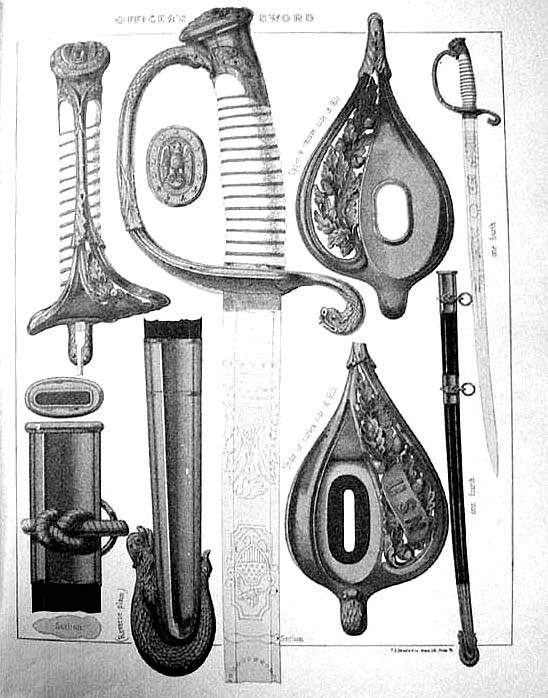MINT CONDITION
ANTIQUE
Model 1852 Officer’s Presentation Sword
=6>
Presented by Chief Turret Captain of USS Indiana BB 1
Length Overall 35
3/4” long
Blade 30 1/4” long by 3/4”
wide 1/4″ Thick LOA 36 1/4″Presented is
a M1852 sword named to Harry E. Stevens, a naval officer born in 1884 who entered the service prior to
1900 as a seaman apprentice 3rd class at Naval Training Station, Newport, RI. Nine years later, at the time he was presented
the sword on December 30, 1909 he was a commissioned officer, most likely with the rank of ensign. This information comes
from official U.S. Navy records for the years 1900, 1911, 1912, 1918 and 1921.Further details are provided
in the 1910 Census
of the United States in which he is listed as a commissioned officer. There are no internet citations that follow his
career, but there are copies of census documents for the years 1900, 1910, 1920 which also show the station and his rank
of service. For example, the 1920 Census lists him as a lieutenant serving in USS Prometheus AR-3. The 1930 census indicates
he entered civilian life. The presenter, Anders G. Lagg is known to have been a chief turret captain, an enlisted rank equivalent
of chief petty officer, serving through the end of WW I.
sword’s throat bandThere is no record of what noteworthy
event occurred for Lagg to have presented his superior with a sword that has a connection with Stevens and the USS Indiana
BB-1. That said, the quality of the sword is exceptional, something that is not seen in what is being offered today’s
naval officers. For this reason alone it should appeal to someone who is seeking the best of what was available at the
Turn of the 20th Century and thereafter in a naval officer’s M 1852 sword.This sword’s
blade is approximately 1/4 inch wider than contemporary swords of this same model.
hilt of the Stevens’ M 1852 sword
DIMENSIONS: Blade:
3/4 inch wide, 1/4 inch thick, 30 1/4 inches long, Hilt 5 1/4 inches long. Length overall 35 3/4 inches. In
scabbard 36 1/4 inches.
Fuller 16 1/2” x 1/2“ Weight sword 2 Lbs 1 1/4 oz.CONDITION:
When received the leather scabbard was in tatters and missing the last 6 inches of its length. However all the hardware was
present. The blade, on the other hand, was immaculate with no stains or darkening and sparkled in its brilliance. The hilt
was very good except that the brass had darkened and there was hardly any evidence remaining of the
original gold wash. The sharkskin covering – shagreen was also in very good condition with only a little loss.The two strand wire wraps
are tight over the shagreen grip’s cover. Most of the gilding was worn off with a patina of age
which was in contrast to the new condition of the blade. Consequently, we decided to have a the sword housed in a newly made scabbard
using the original hardware.
I. Bernstein, Brooklyn,
NY, primarily known as a jeweler, is etched on the obverse ricasso on four lines. On the reverse is a brass proof logo
with a French style fleur de lis centered. The country of origin began to appear on blades starting in 1892 so we
are not certain that it is American made.There are twelve
wraps woven as half hitches in two strand wire on the white shark skin covering the grip. The
single fuller is 21 1/4 inches. The number of stars in the 1852 design was 13.

spotlessThe dolphin on
the drag is mounted with its head on the side away from the hangers per the official design while the eagle on the pommel
faces right surrounded by 13 stars. Thirteen stars
is what was called for by the official 1852 blade design.
sword’s scabbard
The only difference
between the original Model 1852 sword design shown on the left, and that authorized today, is that today, materials such as
plastic substitute for fish and ray skin, and lower quality metalwork is being used. Not so with this sword that conforms
with the original specifications except that the blade was decreased in width as follows:* From
1 1/8 inches to about 1 inch after 1872* To
about 3/4 inch in the later 19th Century,* To
5/8 inch in today’s Navy.The regulation
of 1852 had the eagle on the pommel facing right when viewed from behind. The use of the officer’s sword was suspended
on 15 October 1942 and was not authorized officially again until 1954. Source Naval Historical and Heritage Command.
BB 1 in 1911 at the Brooklyn Navy Yard













